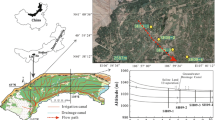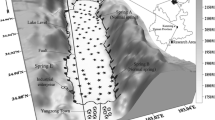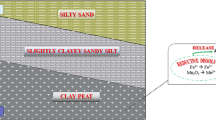Abstract
Groundwater is susceptible to arsenic contamination by sediment with high arsenic content, which is the primary culprit of regional arsenic pollution and poisoning. To explore the influence of the change in hydrodynamic conditions caused by changes in the sedimentary environment over time on arsenic content in sediments during the Quaternary, the hydrodynamic characteristics and arsenic content enrichment of borehole sediments were studied in typical high-arsenic groundwater areas of the Jianghan–Dongting Basin, China. The regional hydrodynamic conditions represented by each borehole location were analyzed, the correlation between the variation in groundwater dynamics characteristics and arsenic content in different hydrodynamic periods was analyzed, and the relationship between arsenic content and grain size distribution was quantitatively investigated using grain size parameter calculation, elemental analysis, and statistical estimates of arsenic content in borehole sediments. We observed that the relationship between arsenic content and hydrodynamic conditions differed between sedimentary periods. Furthermore, arsenic content in the sediments from the borehole at Xinfei Village was significantly and positively correlated with a grain size of 127.0–240.0 μm. For the borehole at Wuai Village, arsenic content was significantly and positively correlated with a grain size of 1.38–9.82 μm size (at 0.05 level of significance). However, arsenic content was inversely correlated with grain sizes of 110.99–716.87 and 133.75–282.07 μm at p values of 0.05 and 0.01, respectively. For the borehole at Fuxing Water Works, arsenic content was significantly and positively correlated with a grain size of 409.6–655.0 μm size (at 0.05 level of significance). Arsenic tended to be enriched in transitional and turbidity facies sediments with normal corresponding hydrodynamic strength but poor sorting. Furthermore, continuous and stable sedimentary sequences were conducive to arsenic enrichment. Fine-grain sediments provided abundant potential adsorption sites for high-arsenic sediments, but finer particle size was not correlated with higher arsenic levels.








Similar content being viewed by others
References
Bai, D. Y. (2010). Quaternary geological environment evolution of Dongting Basin, Doctoral thesis, China University of Geosciences. (in Chinese with English abstract)
Bai, D. Y., Li, S. W., Zhou, K. J., Ma, T. Q., Wang, X. H., Peng, Y. Y., & Li, G. (2010). Tectonic-sedimentary Landform Classification of 1∶250000 Changde Sheet and its implication for researches on quaternary geology and environment of Jianghan-Dongting Basin. Geology in China, 37(2), 280–297. (in Chinese with English abstract).
Belzile, N., & Tessier, A. (1990). Interactions between arsenic and iron oxyhydroxides in lacustrine sediments. Geochimica Et Cosmochimica Acta, 54(1), 103–109.
Benner, S. G., Polizzotto, M. L., Kocar, B. D., Ganguly, S., Phan, K., Ouch, K., Sampson, M., & Fendorf, S. (2008). Groundwater flow in an arsenic-contaminated Aquifer, Mekong Delta. Cambodia. Applied Geochemistry, 23(11), 3072–3087.
BGS and DPHE. (2011). Arsenic contamination of groundwater in Bangladesh, final report. In D. G. Kinniburgh & P. L. Smedley (Eds.), British geological survey report WC/00/19. Keyworth: BGS.
Boulay, S., Colin, C., Trentesaux, A., Clain, S., Liu, Z. F., & Lauer-Leredde, C. (2007). Sedimentary responses to the Pleistocene climatic variations recorded in the South China Sea. Quaternary Reserach, 68, 162–172.
Clark, D. W., Boyle, J. F., Chiverrell, R. C., Lario, J., & Plater, A. J. (2014). A sediment record of barrier estuary behaviour at the mesoscale: Interpreting high-resolution particle size analysis. Geomorphology, 221(11), 51–68.
Duan, Y. H., Gan, Y. Q., Wang, Y. X., Deng, Y. M., Guo, X. X., & Dong, C. J. (2015). Temporal variation of groundwater level and arsenic concentration at Jianghan Plain, central China. Journal of Geochemical Exploration, 149, 106–119.
Duan, Y. H., Gan, Y. Q., Wang, Y. X., Liu, C. X., Yu, K., Deng, Y. M., Zhao, K., & Dong, C. J. (2017). Arsenic speciation in aquifer sediment under varying groundwater regime and redox conditions at Jianghan Plain of Central China. Science of the Total Environment, 607–608, 992–1000.
Folk, R. L., & Word, W. C. (1957). Brazos river bar: A study in the significance of grain size parameters. Journal of Sedimentary Petrology, 27(1), 3–26.
Gan, Y. Q., Wang, Y. X., Duan, Y. H., Deng, Y. M., Guo, X. X., & Ding, X. F. (2014). Hydrogeochemistry and arsenic contamination of groundwater in the Jianghan Plain, central China. Joural of Geochemical Exploration, 138, 81–93.
Gu, Y. S., Guan, S., Ma, T., Zhu, Z. M., Liu, H. Y., Guo, S., & Yu, S. Q. (2018). Quaternary sedimentary environment documented by borehole stratigraphical records in eastern Jianghan Basin. Earth Science, 43(11), 3989–4000. (in Chinese with English abstract).
Guo, H. M., Wang, Y. X., Shpeizer, G. M., & Yan, S. L. (2003). Natural occurrence of arsenic in shallow groundwater, Shanyin, Datong basin, China. Journal of Environmental Science and Health: Part A Environmental Science and Engineering & Toxic and Hazardous Substance Control, 38, 2565–2580.
He, J., & Charlet, L. (2013). A review of arsenic presence in China drinking water. Journal of Hydrology, 492, 79–88.
McManus, J. (1988). Grain size determination and interpretation. In M. Tucker (Ed.), Techniques in sedimentology (pp. 63–85). Oxford: Backwell.
Meharg, A. A., Scrimgeour, C., Hossain, S. A., Fuller, K., Cruickshank, K., Williams, P. N., & Kinniburgh, D. G. (2006). Codeposition of organic carbon and arsenic in Bengal Delta aquifers. Environmental Science and Technology, 40(16), 4928–4935.
Nordstrom, D. K. (2002). Worldwide occurrences of arsenic in groundwater. Science, 296(5576), 2143–2145.
Pi, K. F., Wang, Y. X., Postma, D., Ma, T., Su, C. L., & Xie, X. J. (2018). Vertical variability of arsenic concentrations under the control of iron sulfur-arsenic interactions in reducing aquifer systems. Journal of Hydrology, 561, 200–210.
Rasool, A., Xiao, T., Farooqi, A., Shafeeque, M., Liu, Y., Kamran, M. A., Katsoyiannis, I. A., & Eqani, S. A. M. A. S. (2017). Quality of tube well water intended for irrigation and human consumption with special emphasis on arsenic contamination at the area of Punjab, Pakistan. Environmental Geochemistry and Health, 39(4), 847–863.
Ravenscroft, P., Brammer, H., & Vice-president, K. R. (2009). The hydrogeology of arsenic (3rd ed., pp. 73–117). New York: Wiley.
Rodriguez-Lado, L., Sun, G., Berg, M., Zhang, Q., Xue, H. B., Zheng, Q. M., & Johnson, C. A. (2013). Groundwater arsenic contamination throughout China. Science, 341(6148), 866–868.
Sun, L. Q., Liang, X., Jin, M. G., Ma, B., Zhang, X., & Song, C. (2021b). Ammonium and nitrate sources and transformation mechanism in the Quaternary sediments of Jianghan Plain, China. Science of the Total Environment, 774(2021), 1–14.
Sun, L. Q., Liang, X., Ma, B., Li, J., Zhang, X., & Song, C. (2021a). Characteristics of sedimentary environment since Quaternary in northern Jianghan Basin, China: Reconstruction of paleoenvironments. Quaternary International, 589(2021), 12–24.
Sun, L. Q., Zhang, X., Liang, X., Chang, Z. K., Fu, P. Y., & Zhang, J. (2021c). Identification and characteristics of the sedimentary environment since the quaternary in Zi River Delta, Dongting Basin. Earth Science, 46(9), 3245–3257. (in Chinese with English abstract).
Tang, J., Lin, F. N., Bian, J. M., Liu, W. Z., & Zhang, J. M. (1996). Environmental geochemistry of arsenic in Hetao Plain of Inner Mongolia. Hydrogeology Engineering Geology, 1, 49–54. (in Chinese with English abstract).
Wang, W. L., Blum, P., Boulay, S., Colin, C., Alain, T., Pluquet, F., Bertaux, J., Blamart, D., Buehring, C., & Wang, P. X. (2003). Mineralogy and sedimentology of Pleistocene sediment in the South China Sea. Proceedings of the Ocean Program, 184, 1–21.
Xie, X. J., Wang, Y. X., Duan, M. Y., & Liu, H. Q. (2009). Sediment geochemistry and arsenic mobilization in shallow aquifers of the Datong basin, northern China. Environmental Geochemistry and Health, 31, 493–502.
Yu, Q., Wang, Y. X., Ma, R., Su, C. L., Wu, Y., & Li, J. X. (2014). Monitoring and modeling the effects of groundwater flow on arsenic transport in Datong basin. Journal of Earth Science, 25(2), 386–396.
Zhang, X., Wang, B., Cui, X., Lin, C., Liu, X., & Ma, J. (2018). Total arsenic concentrations in Chinese children’s urine by different geographic locations, ages, and genders. Environmental Geochemistry and Health, 40(3), 1027–1036.
Zou, Y. R., & Cai, Y. L. (1997). Hydrodynamic index method and its application to depositional environment. Journal of China Coal Society, 22(2), 113–116. (in Chinese with English abstract).
Funding
This study was jointly supported by National Natural Science Foundation of China (Nos. 41772268), Major Science and Technology Projects of Ministry of Water Resources of China (SKS-2022062), Key R&D and Promotion Projects of Henan Province: Scientific Research (212102311150), and Independent Research and Development Project of YREC.
Author information
Authors and Affiliations
Contributions
LS helped in conceptualization, methodology, investigation, and writing—original draft preparation; WW contributed to writing—original draft preparation, and writing—reviewing and editing; QL helped in investigation and software; FY and ZS helped in conceptualization and methodology; XZ contributed to data curation and resources; XL performed funding acquisition and supervision; MJ was involved in formal analysis; and LH contributed to writing—reviewing and editing.
Corresponding author
Ethics declarations
Conflict of interest
The authors declare that they have no known competing financial interests or personal relationships that could have appeared to influence the work reported in this paper.
Animal research
No animals were involved in this study.
Consent to participate
Informed consent was obtained from all individual participants included in the study.
Consent for publication
This research did not involve human subjects.
Additional information
Publisher's Note
Springer Nature remains neutral with regard to jurisdictional claims in published maps and institutional affiliations.
Rights and permissions
Springer Nature or its licensor (e.g. a society or other partner) holds exclusive rights to this article under a publishing agreement with the author(s) or other rightsholder(s); author self-archiving of the accepted manuscript version of this article is solely governed by the terms of such publishing agreement and applicable law.
About this article
Cite this article
Sun, L., Wan, W., Luo, Q. et al. Study on the relationship between hydrodynamic conditions and arsenic content in Quaternary sediments. Environ Geochem Health 45, 4703–4717 (2023). https://doi.org/10.1007/s10653-023-01532-9
Received:
Accepted:
Published:
Issue Date:
DOI: https://doi.org/10.1007/s10653-023-01532-9




